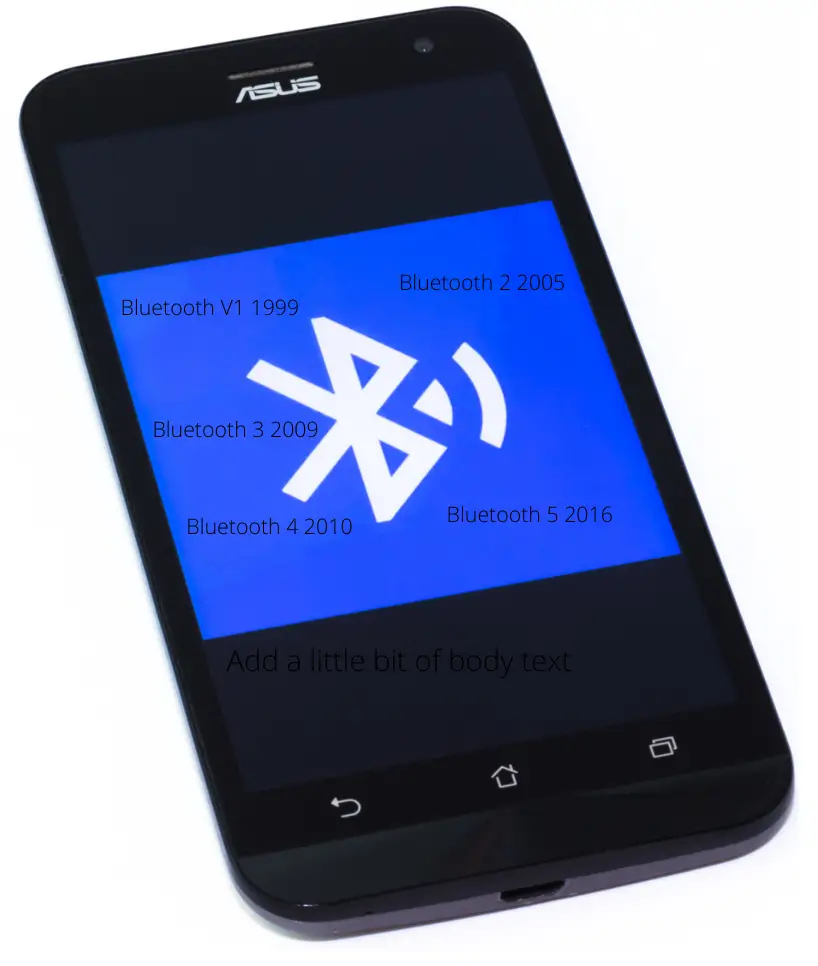Bluetooth technology is a common connectivity feature of most electronic devices these days, including devices in the IoT (Internet of Things).
When you look at their specifications, you’ll see a version number attached to the Bluetooth capability installed in the device.

Have you ever wondered what that number means and how it affects the device you’re using?
This article will briefly explain what Bluetooth is, the history of its development, and how it has changed with each updated version. Importantly too, I’ll take you through how the current version improves your connectivity experience and what future versions are likely to bring.
Before We Start: Here’s a Brief History of the Different Bluetooth Versions
- Bluetooth 1.0-1.2 (1999)
- Bluetooth 2.0-2.1 (2005)
- Bluetooth 3.0 (2009)
- Bluetooth 4.0-4.2 (2010)
- Bluetooth 5-5.2 (2016)
Now let’s find out what is meant by the term “Bluetooth technology.”
What is Bluetooth?
Bluetooth is a wireless (i.e., no wires used) technology that allows for data exchange over short distances based on a global wireless communication standard.
Ericsson, the Swedish multinational company, headquartered in Stockholm, invented the technology from 1989 to 1994. They developed it as an alternative to RS-232 data cables that were a standard for serial transmission of data at the time.
Instead of cable, it meant that short-wavelength UHF radio waves in the ISM band from 2.402 to 2.485 GHz transmitted the data.
However, it took four years to formalize the specifications as a standard, with the first version released in 1999.
The Bluetooth Special Interest Group (SIG), now including over 35,000 companies, took over the specification development, managing the qualification program, and protecting the trademarks.
I’ll get into more detail on Bluetooth shortly. But to digress briefly.
Have you ever wondered about the name?
It’s unusual because it doesn’t describe the technology, unlike the other wireless technologies, “radio frequency” and “infrared.”
Bluetooth: Where Does the Name Come From?
The founders of Bluetooth SIG took the name “Bluetooth” from King Harald “Blåtand” Gormsson, a Danish king who united Denmark and Norway. A rotting tooth in the king’s mouth earned him the nickname “Blue tooth.”
The founders chose it as a temporary name until they could think of something else. But it has stuck as the name to this day and is not likely to change.
Now back to details on how Bluetooth works.
How does Bluetooth work?
Bluetooth works by sending a signal from a transmitting device to a receiving device. That signal can be for data or audio but cannot happen until the two wireless devices pair with each other.
Pairing is the joining procedure between the two Bluetooth-enabled devices. Once pairing happens, it means that later connections don’t require the entry of access or security information, like passwords or passkeys. It also means that transmission is much faster.
Some Bluetooth devices use NFC (near field communication), allowing Bluetooth connections to be forged by simply touching the two devices together.
There’s a standard operating frequency of 2.402 – 2.480 GHz for all Bluetooth devices and all versions.
Data or audio packets stay within this frequency range but can change from one specific frequency to another within that range when heavy congestion happens. This design feature ensures a quality connection providing enhanced sound quality with limited dropouts unless an object blocks the transmission.
Such quality connections with the mobility of no wires mean that many different uses have been found for Bluetooth over the years.
What Is Bluetooth Used For?
In the early years, and to this day, Bluetooth has become commonly used for wireless headphones and speakers, other audio hardware, and keyboards, mice, and game controllers.
And now you find Bluetooth used in PCs, laptops, and tablets. In addition, their use has expanded to smartphones, wearable devices, and between various smart home devices and the Internet of Things (IoT) devices.
The list of devices is constantly expanding.
Let’s examine that in greater detail later when we look at the capabilities of Bluetooth 5.2.
In the meantime, let’s look at what has happened to Bluetooth since the first release in 1999.
Versions 1.0 – 3.0: Bluetooth Classic
The first three versions of Bluetooth are now called the classic Bluetooth versions.
Bluetooth 1.0-1.2 (1999)
Bluetooth 1 is an obsolete version of Bluetooth no longer implemented in modern electronics.
In these early days to 2005, the technology was still immature:
- there were difficulties with pairing
- the top data transfer speed was just 1mps
- a range only to a little over 30 feet (10 meters)
- transmission lacked anonymity
Bluetooth 2.0 (2005) – 2.1 (2007)
Bluetooth 2.1 extended the range to just over 100 feet (33 meters), increased the data rate to 3mps, and included a feature called secure, simple pairing (SSP).
SSP significantly improved pairing connectivity and strengthened security.
Bluetooth 3.0 (2009)
In this version, speed increased to a possible 24 Mbps of data transfer. But this speed doesn’t come via the Bluetooth link.
Bluetooth sets up the connection, but the data transmits via a co-located 802.11 local area network link.
The problem with version 3.0 was the increased power consumption, which meant battery usage increased faster with less time for use before needing to replace or recharge the batteries.
It also meant that Bluetooth was impractical for IoT use.
This all changed with the release of Bluetooth 4.0.
Versions 4.0 – 5.0: Bluetooth Low Energy
There have been two major releases since Bluetooth 3.0.
Bluetooth 4.0 (2010) – 4.1 (2013) – 4.2 (2014)
Bluetooth 4.0 entered the market in 2010 with a new category of Bluetooth: Bluetooth Low Energy (BLE).
A new category aimed at applications requiring low power consumption. BLE returned to a lower data throughput of 1Mbps using the GFSK modulation scheme.
Bluetooth Low Energy doesn’t suit those applications like wireless Bluetooth headphones that require a continuous stream of data.
But it does suit IoT applications which only need to send small bits of data periodically.
BLE focuses on keeping energy demands low, so making many coin-cell battery-operated IoT applications possible.
You can now find these button batteries used in a broad range of consumer and household products, including remote controls, watches, computers, cameras, calculators, torches, flameless candles, fitness devices, digital kitchen and bathroom scales, musical greeting cards, and home medical devices. All devices that don’t have large volumes of data to send.
But the Bluetooth 4 series of versions didn’t just support low energy consumption. Other enhancements included:
- increasing the connection range to just under 200 feet (60 meters)
- reducing the interference with 4G/LTE signals
- improving the first pairing and the re-pairing process between devices
- improving data transmission and privacy
Bluetooth 5.0 (2016) – 5.1 (Jan 2019) – 5.2 (Dec 2019)
Bluetooth 5.0 is the latest Bluetooth version and came with a fresh marketing approach.
SIG changed the name to Bluetooth 5, with the point numbers dropped from the name.
Bluetooth 5 continued the focus on IoT devices to give a better operating framework.
The notable improvements included:
- increasing the bandwidth capacity of low energy devices to 2 Mbps
- increasing the connection range to around 780 feet (240 meters)
- introducing a new audio protocol (LC3 – Low Complexity Codec) that transfers audio data at lower bitrates without sacrificing audio quality
- reducing power consumption
- increasing message capacity
- ensuring backward capacity with earlier versions of Bluetooth 4
- introducing a dual audio feature allowing two different devices to connect at the same time
Bluetooth 5 introduced a wide range of new features and enhanced capability that is impressive. But like all changes, it will take time to feel the full impact, and for some folks, that wait may not be a drawback. So let’s consider why that would be so.
Stay with Bluetooth 4 or Go with Bluetooth 5?
Bluetooth 4 was a significant step forward, and the value and enjoyment you get from the improvements provided by your Bluetooth 4 devices will continue.
Buying a Bluetooth 5 device doesn’t lock you out of connecting with your existing Bluetooth 4 enabled devices. There is backward compatibility, but there is a warning which you’ll learn shortly.
To enjoy the full benefits of your new Bluetooth 5 device, you’ll have to replace your existing Bluetooth 4 peripherals with Bluetooth 5 peripherals. That could get expensive, so it might help if you understand the specific benefits of Bluetooth 5 to figure out whether it’s worth that extra expense.
The three key factors that differ between Bluetooth versions are range, data speed, and power consumption.
So, let’s look at these first then consider other factors that are also important in deciding whether to move to Bluetooth 5.
Range
There is an increased range with Bluetooth 5 from 200 to 787 feet. The distance is shorter indoors because obstacles like concrete walls reduce the strength of the radio signal.
So, the length indoors increases from 30 to 130 feet which is still a considerable increase.
Data Speed
Bluetooth 5 doubles the speed to 2 Mbps which dramatically improves the response time between devices.
Power Consumption
Power usage with Bluetooth 5 is much less and makes for far longer battery life.
Compatibility
Bluetooth 5 is backward compatible with Bluetooth 4 except for the newer enhancements like Dual Audio. So, for example, if you want to play music from one phone on two different speakers or connect two pairs of headphones to a single phone, you have no choice but to upgrade to Bluetooth 5.
Reliability
This factor is hard to evaluate. But the addition of the following capabilities suggests faster data transfer speeds, less broadcast time, and reduced signal interference which makes for improved reliability:
- increased message capacity
- improved frequency hopping
- avoidance of competing LTE transmitting channels
Upgrading to Bluetooth 5 will be a personal choice based on the factors discussed above and whether you believe your move will improve the overall experience you get from using your devices.
The good thing is that there is no urgent rush, and in any event, there are still few devices yet released with Bluetooth 5.

